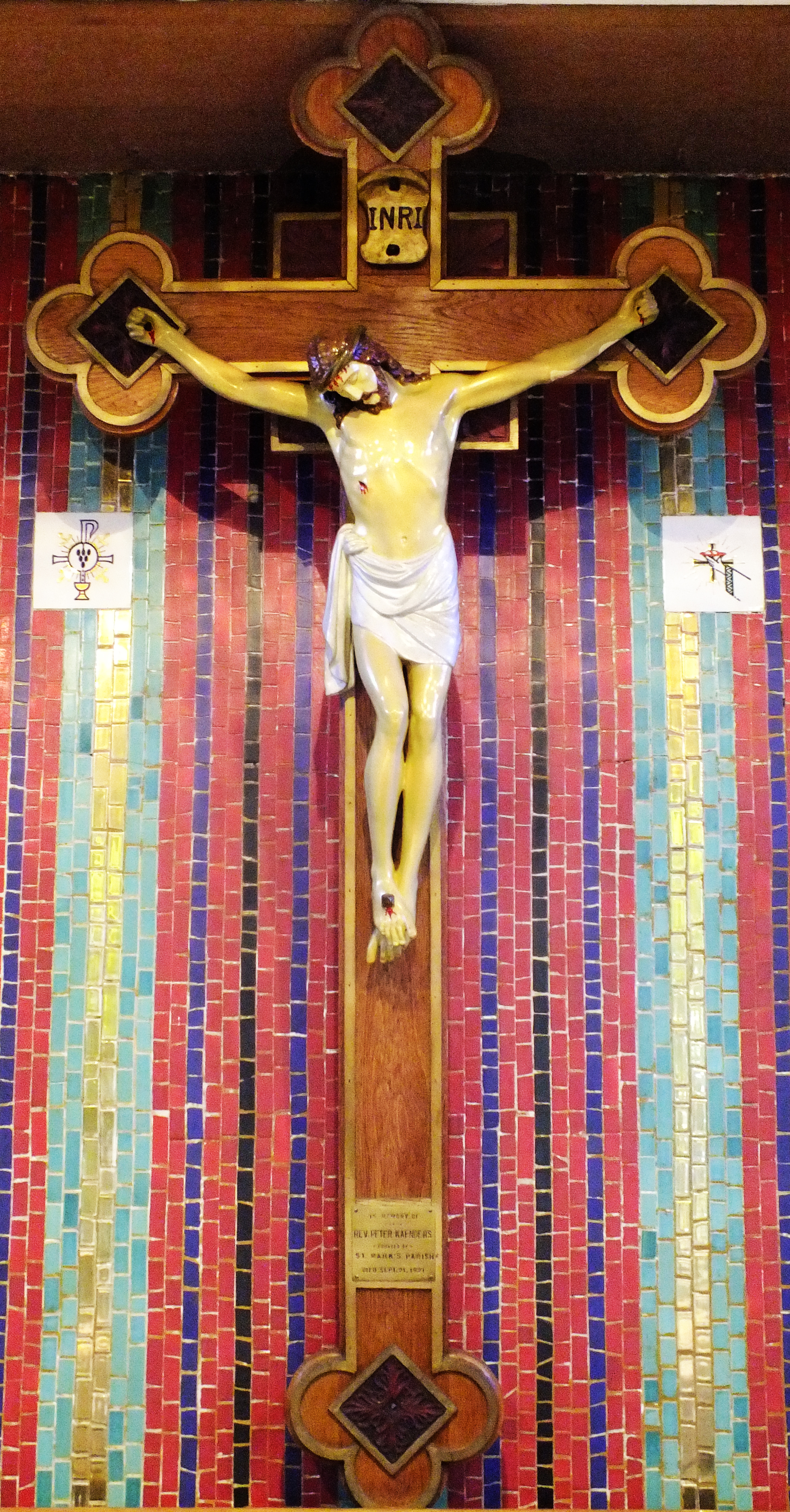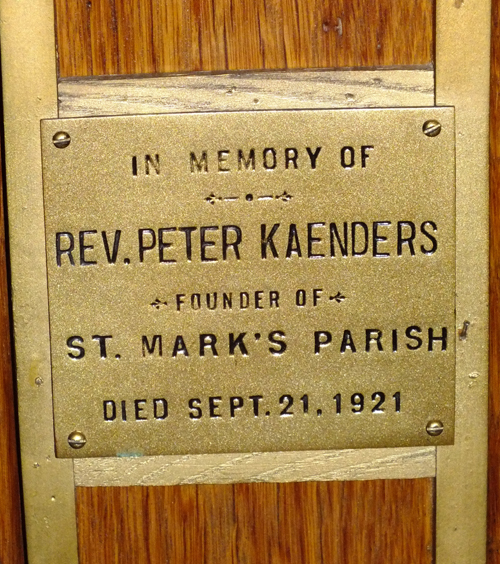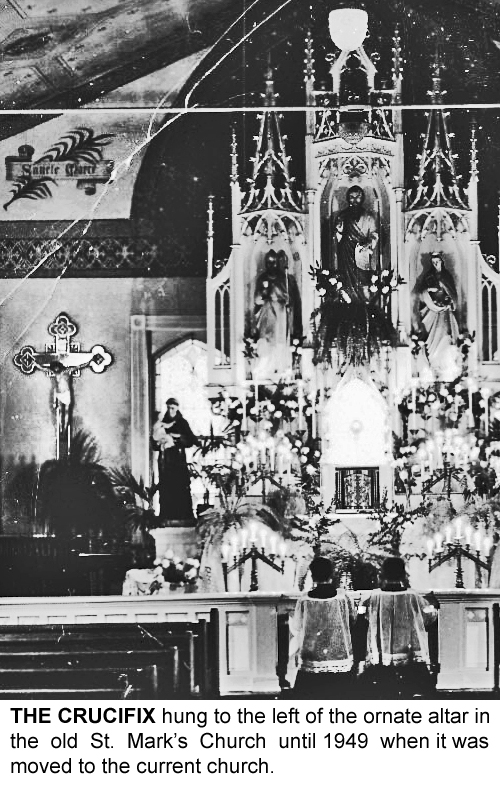





|
Dear Friend: "Story of the Crucifix" at St. Mark's Venice, Illinois. In remembrance of Rev. Fr. Peter Paul Kaenders. Sincerely and graciously yours John L. Fechte (March 23, 1877-September 4, 1957) The cause which brought on the First World War had been smouldering for several years. These causes were the greed, aggression and ambition of the Nations of Europe. A spark was the only thing necessary to bring on the greatest conflict in history between the Nations of the World. The assassination of Archduke Ferdinand, Austrian heir-apparent, and his wife, furnished this spark. This event occurred at Serajeve, in Bosnia, on June 28, 1914.  One act of aggression after another by the countries of
Europe followed, So that an armament race ensued in preparation for the catastrophe
of the most terrible war in the history of the world. Because of the interference with
our liberties and the aggression of the countries then at war, the United States was
compelled to protect itself and its citizens against the hostilities of the European
countries. In the month of April, 1917, the atrocities became so unbearable that it was
impossible for the United States to remain neutral any longer, and we entered the war.
One act of aggression after another by the countries of
Europe followed, So that an armament race ensued in preparation for the catastrophe
of the most terrible war in the history of the world. Because of the interference with
our liberties and the aggression of the countries then at war, the United States was
compelled to protect itself and its citizens against the hostilities of the European
countries. In the month of April, 1917, the atrocities became so unbearable that it was
impossible for the United States to remain neutral any longer, and we entered the war.Up to this time the United States had relied on the Regular Army and Navy and volunteer enlistments. On March 15, 1917 the “Selective Military Conscription Bill” was passed. It was called the Selective Service Act. And was intended to make the burden of the war as light as possible on the people and the Industries. On March 18, 1917 the first number for the selective service was drawn, and on June 5, 1917 the first American troops were sent abroad and landed in Europe. The Selective Service was put into operation, and in order that the Selective Service Boards would get information as to the status and qualifications of those whose numbers were drawn and would be called, all men between ages of 21 and 30 years were required to register and to fill out and file with their respective Service Boards a questionnaire, giving information as to their status and qualifications. These questionnaires were quite lengthy and complicated, and only a few would venture to make them themselves. The Notaries in the jurisdiction would volunteer one day each week to serve at the office of the Selective Service Board, without charge for their service to the men. Many of the men found it inconvenient to go to the office of the Selective Service Board, and would prefer to have the questionnaire made out at the office of a Notary Public.  The writer
assisted as many as he could without charge, but it began to take too much time from
his office work, so that it became impossible to continue along this line. Still desiring
to assist all that he could, he decided on a plan to accumulate a fund to be used for the
benefit of the men who would be called into service. As the men came to him to have
him assist them to have their questionnaire made out, he would ask them to place a
small sum, as they wished, in a box on the desk. This sum so accumulated was used to
send gifts to the men. Such gifts as cigarettes, candy, shaving cream, safety razor sets
and blades.
The writer
assisted as many as he could without charge, but it began to take too much time from
his office work, so that it became impossible to continue along this line. Still desiring
to assist all that he could, he decided on a plan to accumulate a fund to be used for the
benefit of the men who would be called into service. As the men came to him to have
him assist them to have their questionnaire made out, he would ask them to place a
small sum, as they wished, in a box on the desk. This sum so accumulated was used to
send gifts to the men. Such gifts as cigarettes, candy, shaving cream, safety razor sets
and blades.To some he sent religious articles such as Rosaries, miniature prayer books in leather cases, and other articles which a man in service might like. The writer also corresponded with a number of the men. Then came the Great Day, November 11, 1918 at eleven o’clock .A.M., when the Armistice was signed and the most terrible WAR in history was ended. No more men were called under the Selective Service Act, and soon the men began to come back home, it was not necessary to send any more gifts. At this time the writer had about One hundred dollars left over after having used about Three hundred dollars for gifts to the men in service of Our Country, from the contributions from those whom he assisted in preparing their questionnaire. This fund was kept in a separate account, to be used for some purpose beneficial to the men who served their Country, or for some other purpose which might present itself. Several years later, on September 21, 1921, at the age of only sixty-five years, Our Beloved Pastor, Rev. Fr. Peter Paul Kaenders died and went to his Eternal Reward. He was Pastor of St. Mark’s Church from 1880 until his death. He built two churches, two schools, two parsonages, homes for the sisters and teachers. He equipped and operated a hospital at Venice, which he named St. Elizabeth’s Hospital. Then after a few years he acquired the hospital at Granite City, naming it St. Elizabeth’s Hospital. After operating it a few years with lay nurses and Hospital Sisters, he turned it over to the Sisters of Divine Providence. This community of Hospital Sisters still operate the Hospital, and have greatly enlarged it. Father Kaenders was a friend of all, and died in the Hospital he so loved.  Here was the
opportunity to use the balance of the fund for a Memorial to Good Father
Kaenders. As such a memorial nothing would be more fitting and appropriate that
a large Crucifix to be placed on the wall of St. Mark’s Church, where he so often
offered the Holy Sacrifice of the Mass.
Here was the
opportunity to use the balance of the fund for a Memorial to Good Father
Kaenders. As such a memorial nothing would be more fitting and appropriate that
a large Crucifix to be placed on the wall of St. Mark’s Church, where he so often
offered the Holy Sacrifice of the Mass.With the assistance of Rev. Fr. Linus G. Kipping, who succeeded Father Kaenders as Pastor of St. Mark’s, a large Crucifix was selected and placed beside the Altar. A brass plate inscribed “In Memory of Rev. Peter Paul Kaenders” was placed near the bottom of the Crucifix. The Crucifix remained in the same place during the pastorate of Fr. Kipping, until 1930 when he was succeeded by Rev. Fr. Charles Flori, who was Pastor until 1938, at which time Fr. Flori was succeeded by Rev. Fr. Fred W. Klasner. During the pastorate of Fr. Klasner it became necessary to have a larger church, and with the hard work and good management of Fr. Klasner, and with the assistance of the members of St. Mark’s, a new church soon became a reality. The new church is of modern design and architecture, has only three steps from the sidewalk to the main floor of the church, whereas the old church had thirty-seven steps. The interior is also of modern design, having a marble Altar and Tabernacle, and here is where the Crucifix fitted into the plan and design of the interior of the new church, and was removed from the old church to the new church. The Crucifix is now the most prominent part of the Altar, being above the marble Tabernacle, so that the feet of the Crucified Christ appears to rest on the top of the Tabernacle. As a background for the Altar and Crucifix is a beautiful mosaic appearing as a curtain. Special lighting was installed with flood lights directed on the Crucifix and Altar. This Crucifix will remain here for many years as a Memorial to Rev. Fr. Peter Paul Kaenders. In July, 1952, to the regret of all of the people of St. Mark’s and Venice, Fr. Klasner was transferred to a larger parish, at Decatur, Illinois. At the same time Rev. Fr. Robert C. McCarthy was transferred to St. Mark’s and is already beginning to be loved by the members of St. Mark’s. The Crucifix on the Altar will be a remembrance of Good Father Kaenders as long as there is a St. Mark’s Church in Venice, Illinois. This Memorial Crucifix was made possible by the contributions of men who were about to enter the Military Service of Our Country, to protect our rights and liberties. The contributions were made to the writer for the assistance in preparing and filling out questionnaires required for men to enter the Military Service of Our Country in World War I.  |
